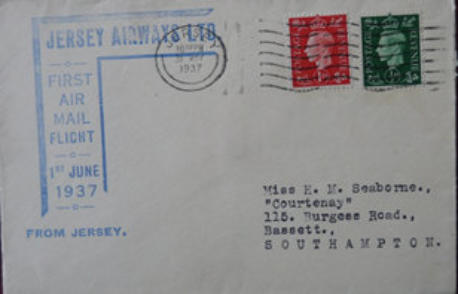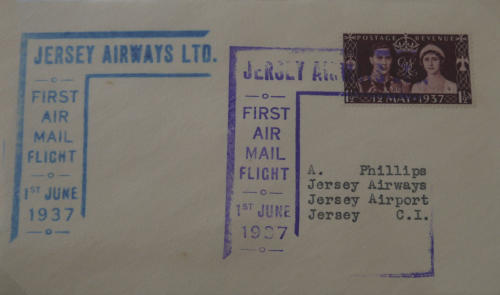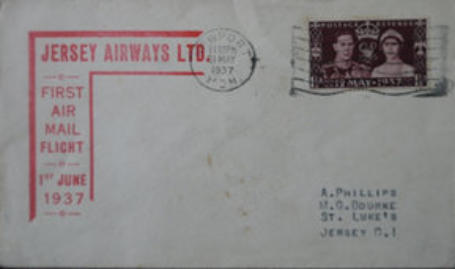
Jersey Airways
The idea for Jersey Airways was formed by L.T.H. Greig, who wanting to get a sick friend home from Jersey quickly was quoted £30 for a charter. He
decided Jersey needed an air service and he persauded W.L. Thurgood to join him as a partner. An interesting future article could be ‘The London
Passenger Transport Act and the Development of Aviation 1933-1934’. There is no doubting that the Act drove some large coach company owners into
the Aviation business. John Sword started ‘Midland and Scottish Ferries’ and Edward Hillman started ‘Hillman Airways’. Thurgood was forced to sell his
‘Peoples Motor Services’ and joined Greig in forming Jersey Airways on the 9th December 1933. During 1933 the idea of an airport for Jersey was being
actively pursued. However, Greig did not wait for the airport and persuaded the Official in charge of beaches to grant him the sole rights to land his
planes on St Aubin’s beach at St Heliers. It was a good move as Jersey would have to wait another four years for an airport. The first commercial service
took place on 18 December, with a passenger service from Jersey to Portsmouth. The first flight was oversubscribed and the airline had to hire two more
planes to take the load. Although it was registered in Jersey the planes could not be left in Jersey due to the tides, so were kept and maintained at the
municipal airport at Portsmouth (moving to Southampton Airport in 1935). Jersey Airport opened on 10 March 1937 and the mail contract began on 31
May 1937 and Jersey Airways was able to operate a fixed timetable that no longer depended on the state of the tides. This was between Jersey and
Southampton only. Mail to London was sent by train from Southampton. Jersey Airways was possibly the most successful of all the airlines in the 1930’s
and continued until 1947 when it was nationalised.
Experimental Mail Flight using Jersey Airlines Charter. 28th June 1935
In the Souvenir mail section, I noted that Redgrove in his 1940 book had called the Humber Air Ferry the ‘The East Yorkshire Motor Services’ which was a strange name for an airline, and not the operating name of the firm. When he got to flights to Jersey, he was at it again and called the Experimental flight of the 28th June, Whoopee Sports Ltd. Like ‘East Yorkshire Motor Services’ the name has stuck even though Whoopee Sports had nothing to do with this flight. The only connection is the person who organised the flight’ Mr Cann who was the owner of Whoopee sports, but this was a different enterprise. Mr Cann sought to run an air service from Plymouth to Jersey and as well as fly passengers he sought to prove that he could provide a mail service. On 28th June he chartered a Jersey Airlines De Havilland Dragon which flown by Bill Caldwell successfully carried five passengers and around hundred envelopes. The envelopes were all posted late on the 27th and addressed to R. E. E. Cock at Roborough Aerodrome. From here they were put on the plane and flown to Jersey. After delivery to Jersey, a grey label was placed over the Plymouth address with a new address once again to Mr Cock but now at the Royal Yacht Hotel. A 1 1/2d Coronation stamp was applied down the left-hand side and they were posted once more. Mr Cock’s hopes to set up a rival airline were doomed to failure as Jersey Airways had the landing rights to the beach and there was nowhere else suitable to land. Despite the successful flight, the GPO were of the view that a beach that was subject to tides was not suitable for a reliable mail service.
All the envelopes sent on the flight were identical with the
same stamps, the same grey label and the same 1 1/2d
coronation stamp down the left-hand side. The first
postmark from Plymouth can be 1 a.m., 3 a.m. or 5 a.m. on
the 28th. The Jersey postmark is always a machine
cancellation of the 28th at 4.15 p.m. A few of the envelopes
were, as in this example signed in pencil by the pilot ‘Bill’
Caldwell, but these are uncommon. I have seen one
envelope with a red cachet stating, ‘EXPERIMENTAL FLIGHT /
PLYMOUTH TO JERSEY’, but this was almost certainly applied
afterwards.
First flights and new mail contract. 31st May 1937.
Jersey Airways flew a first flight under a new airmail contract on the 31st May 1937. The flight was from Jersey to Southampton and return. There was no flight to London. Mail sent to London was flown to Southampton and forwarded by Rail.The Jersey Cachets
There are four cachets related to the first flight on the 31st May. They were a collaboration between the airline and Anthony Phillips of Newport. The exact status of these cachets is not clear. Between Jersey and Southampton and Southampton the cachets in blue and purple were provided by the airline. The status of the London cachet is less clear. Redgrove says the green receiving cachet was applied by the airline, but there is some suggestion that the green London receiving cachet was applied by Phillips. There is some strength to this argument as all the covers with green receiving cachets appear to be addressed to Phillips in London. I think we will never know. The red cachet was applied by Phillips for mail from Newport and to Newport. Receiving cachets were applied to the back of the envelope. Just to add to the confusion sometimes there are two cachets on the front and there are examples where the cover has not been posted (see below). We can see below that covers sent to Phillips have receiving cachets, but this does not seem to be the norm. All mail I have seen sent to London is to Phillips and has a green receiving cachet.
Copyright
© 2022 Robert Farquharson All Rights Reserved


British Internal Airmails of the 1930’s

First Flight Southampton to Jersey

F

This cover has been sent from Southampton to Jersey, but has
not been posted. The stamp is purely decorative.

First Flight Newport to Jersey

Philips Newport to Jersey. Receiving cachet.

First Flight Jersey to London

First Flight Southampton to Jersey. No receiving cachet

First Flight Jersey to Southampton.

First Flight Jersey to London
London receiver.

Jersey Airways
The idea for Jersey Airways was formed by L.T.H. Greig, who wanting to get a sick friend home from Jersey quickly was quoted £30 for a charter. He
decided Jersey needed an air service and he persauded W.L. Thurgood to join him as a partner. An interesting future article could be ‘The London
Passenger Transport Act and the Development of Aviation 1933-1934’. There is no doubting that the Act drove some large coach company owners into
the Aviation business. John Sword started ‘Midland and Scottish Ferries’ and Edward Hillman started ‘Hillman Airways’. Thurgood was forced to sell his
‘Peoples Motor Services’ and joined Greig in forming Jersey Airways on the 9th December 1933. During 1933 the idea of an airport for Jersey was being
actively pursued. However, Greig did not wait for the airport and persuaded the Official in charge of beaches to grant him the sole rights to land his
planes on St Aubin’s beach at St Heliers. It was a good move as Jersey would have to wait another four years for an airport. The first commercial service
took place on 18 December, with a passenger service from Jersey to Portsmouth. The first flight was oversubscribed and the airline had to hire two more
planes to take the load. Although it was registered in Jersey the planes could not be left in Jersey due to the tides, so were kept and maintained at the
municipal airport at Portsmouth (moving to Southampton Airport in 1935). Jersey Airport opened on 10 March 1937 and the mail contract began on 31
May 1937 and Jersey Airways was able to operate a fixed timetable that no longer depended on the state of the tides. This was between Jersey and
Southampton only. Mail to London was sent by train from Southampton. Jersey Airways was possibly the most successful of all the airlines in the 1930’s
and continued until 1947 when it was nationalised.
Experimental Mail Flight using Jersey Airlines Charter. 28th June 1935
In the Souvenir mail section, I noted that Redgrove in his 1940 book had called the Humber Air Ferry the ‘The East Yorkshire Motor Services’ which was a strange name for an airline, and not the operating name of the firm. When he got to flights to Jersey, he was at it again and called the Experimental flight of the 28th June, Whoopee Sports Ltd. Like ‘East Yorkshire Motor Services’ the name has stuck even though Whoopee Sports had nothing to do with this flight. The only connection is the person who organised the flight’ Mr Cann who was the owner of Whoopee sports, but this was a different enterprise. Mr Cann sought to run an air service from Plymouth to Jersey and as well as fly passengers he sought to prove that he could provide a mail service. On 28th June he chartered a Jersey Airlines De Havilland Dragon which flown by Bill Caldwell successfully carried five passengers and around hundred envelopes. The envelopes were all posted late on the 27th and addressed to R. E. E. Cock at Roborough Aerodrome. From here they were put on the plane and flown to Jersey. After delivery to Jersey, a grey label was placed over the Plymouth address with a new address once again to Mr Cock but now at the Royal Yacht Hotel. A 1 1/2d Coronation stamp was applied down the left-hand side and they were posted once more. Mr Cock’s hopes to set up a rival airline were doomed to failure as Jersey Airways had the landing rights to the beach and there was nowhere else suitable to land. Despite the successful flight, the GPO were of the view that a beach that was subject to tides was not suitable for a reliable mail service.First flights and new mail contract. 31st May 1937.
Jersey Airways flew a first flight under a new airmail contract on the 31st May 1937. The flight was from Jersey to Southampton and return. There was no flight to London. Mail sent to London was flown to Southampton and forwarded by Rail.The Jersey Cachets
There are four cachets related to the first flight on the 31st May. They were a collaboration between the airline and Anthony Phillips of Newport. The exact status of these cachets is not clear. Between Jersey and Southampton and Southampton the cachets in blue and purple were provided by the airline. The status of the London cachet is less clear. Redgrove says the green receiving cachet was applied by the airline, but there is some suggestion that the green London receiving cachet was applied by Phillips. There is some strength to this argument as all the covers with green receiving cachets appear to be addressed to Phillips in London. I think we will never know. The red cachet was applied by Phillips for mail from Newport and to Newport. Receiving cachets were applied to the back of the envelope. Just to add to the confusion sometimes there are two cachets on the front and there are examples where the cover has not been posted (see below). We can see below that covers sent to Phillips have receiving cachets, but this does not seem to be the norm. All mail I have seen sent to London is to Phillips and has a green receiving cachet.
Copyright
© 2020 Robert Farquharson All Rights Reserved


British Internal Airmails of the 1930’s

First Flight Southampton to Jersey



First Flight Newport to Jersey






















